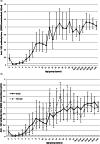Seroepidemiology of varicella zoster virus infection in Vojvodina, Serbia
- PMID: 29909816
- PMCID: PMC9507937
- DOI: 10.1017/S0950268818001619
Seroepidemiology of varicella zoster virus infection in Vojvodina, Serbia
Abstract
The present cross-sectional serosurvey constitutes the first effort to describe the varicella zoster virus (VZV) seroepidemiology in Serbia. An age-stratified serum bank of 3570 residual samples collected between 2015 and 2016 in each of the seven districts of the Vojvodina Province was tested for IgG anti-VZV antibodies with an enzyme immunoassay. Results were standardised into common units according to the European Sero-Epidemiology Network (ESEN2) methodology. Univariable and multivariable analyses were used to examine the relationships between standardised anti-VZV positivity or logarithmically transformed antibody titres and demographic features of study subjects. Seropositivity (85% overall) increased with age, in parallel with geometric mean titres. By the time of school entry, 68% of children were immune. The slower subsequent acquisition of immunity leaves epidemiologically relevant proportions of adolescents (7%), young adults (6%) and especially females of reproductive age (6%) prone to more severe forms of varicella. In the ongoing pre-vaccine era, natural infection provides a high level of collective immunity, with the highest VZV transmission in children of preschool age. The detected gaps in VZV immunity of the Serbian population support the adoption of the official recommendations for varicella immunisation of non-immune adolescents and young adults, including non-pregnant women of childbearing age.
Keywords: Antibodies to varicella zoster virus (anti-VZV); ESEN2; Europe; chickenpox; seroprevalence; standardisation; vaccines and immunisation.
Conflict of interest statement
None.
Figures




Similar articles
-
Varicella zoster virus transmission dynamics in Vojvodina, Serbia.PLoS One. 2018 Mar 5;13(3):e0193838. doi: 10.1371/journal.pone.0193838. eCollection 2018. PLoS One. 2018. PMID: 29505590 Free PMC article.
-
Varicella-zoster virus seroprevalence in children and adolescents in the pre-varicella vaccine era, Germany.BMC Infect Dis. 2017 May 19;17(1):356. doi: 10.1186/s12879-017-2461-2. BMC Infect Dis. 2017. PMID: 28525973 Free PMC article.
-
Nosocomial transmission of chickenpox and varicella zoster virus seroprevalence rate amongst healthcare workers in a teaching hospital in China.BMC Infect Dis. 2019 Jul 5;19(1):582. doi: 10.1186/s12879-019-4222-x. BMC Infect Dis. 2019. PMID: 31277589 Free PMC article.
-
Varicella Zoster Virus: A Common Cause of Stroke in Children and Adults.J Stroke Cerebrovasc Dis. 2016 Jul;25(7):1561-1569. doi: 10.1016/j.jstrokecerebrovasdis.2016.03.052. Epub 2016 Apr 29. J Stroke Cerebrovasc Dis. 2016. PMID: 27138380 Free PMC article. Review.
-
Varicella zoster virus-associated morbidity and mortality in Africa - a systematic review.BMC Infect Dis. 2017 Nov 14;17(1):717. doi: 10.1186/s12879-017-2815-9. BMC Infect Dis. 2017. PMID: 29137604 Free PMC article.
Cited by
-
Seroprevalence Study of Anti-HBs Antibodies in the General Population of Vojvodina, Serbia.Medicina (Kaunas). 2024 Mar 6;60(3):436. doi: 10.3390/medicina60030436. Medicina (Kaunas). 2024. PMID: 38541162 Free PMC article.
-
Declining seroprevalence of hepatitis A in Vojvodina, Serbia.PLoS One. 2019 Jun 4;14(6):e0217176. doi: 10.1371/journal.pone.0217176. eCollection 2019. PLoS One. 2019. PMID: 31163046 Free PMC article.
-
Detection of Circulating VZV-Glycoprotein E-Specific Antibodies by Chemiluminescent Immunoassay (CLIA) for Varicella-Zoster Diagnosis.Pathogens. 2022 Jan 5;11(1):66. doi: 10.3390/pathogens11010066. Pathogens. 2022. PMID: 35056014 Free PMC article.
-
Sero-epidemiological study in prediction of the risk groups for measles outbreaks in Vojvodina, Serbia.PLoS One. 2019 May 9;14(5):e0216219. doi: 10.1371/journal.pone.0216219. eCollection 2019. PLoS One. 2019. PMID: 31071124 Free PMC article. Clinical Trial.
-
Characterization of neutralizing versus binding antibody and T cell responses to varicella-zoster virus in the elderly.Sci Rep. 2025 Apr 21;15(1):13776. doi: 10.1038/s41598-025-98107-8. Sci Rep. 2025. PMID: 40258885 Free PMC article.
References
-
- World Health Organization (2014) Varicella and herpes zoster vaccines: WHO position paper, June 2014. The Weekly Epidemiological Record 89, 265–288.
-
- Helmuth IG et al. (2015) Varicella in Europe – a review of the epidemiology and experience with vaccination. Vaccine 33, 2406–2413. - PubMed
-
- European Centre for Disease Prevention and Control (2015) Varicella Vaccination in the European Union. Stockholm: ECDC, Available at http://ecdc.europa.eu/en/publications/Publications/Varicella-Guidance-20... (Accessed 15 December 2016).
Publication types
MeSH terms
LinkOut - more resources
Full Text Sources
Other Literature Sources

